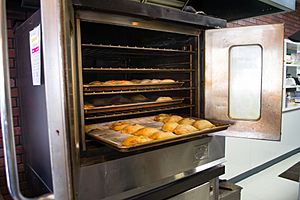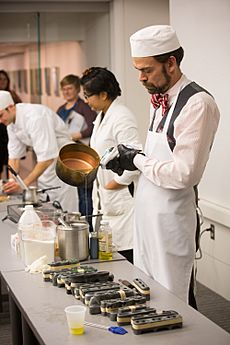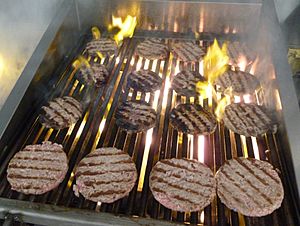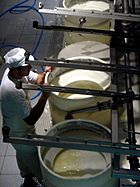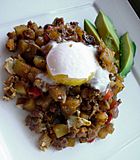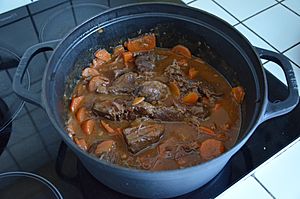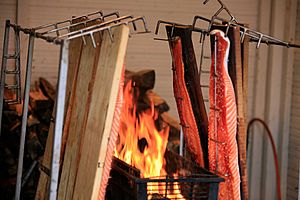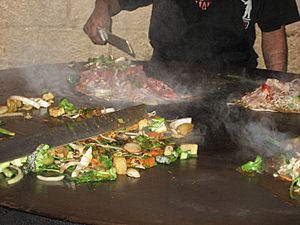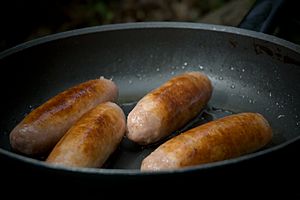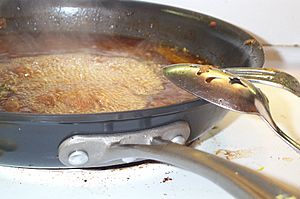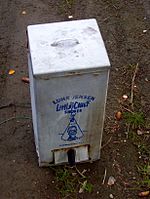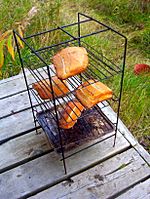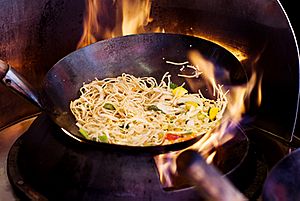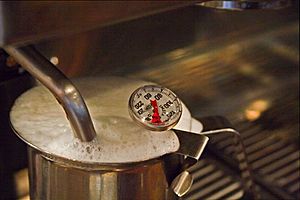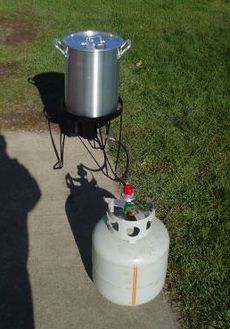List of cooking techniques facts for kids
Cooking is all about getting food ready to eat, often by using heat! There are so many different ways to cook, and these methods change all over the world. Why? Because of different places, money, traditions, and even what's popular. How well a meal turns out also depends on the cook's skills and what tools and ingredients they have, like fresh butter.
This article lists many common cooking techniques used to prepare food.
A
- Acidulate
- To use an acid like lemon juice or vinegar to stop food from browning, change its taste, or make it safe for canning.
- al dente
- This Italian phrase means "to the tooth." It's used for food, usually pasta, cooked until it's tender but still a little firm when you bite it.
- Amandine
- A cooking term meaning a dish is served with almonds. Food served amandine is often cooked with butter and then topped with toasted almonds.
- aspic
- A savory jelly made from meat broth. Foods served in aspic are often placed inside or on top of this jelly.
- au gratin
- Food prepared au gratin is topped with breadcrumbs or cheese and then browned under a broiler (a heating element that cooks from above).
- au jus
- Foods served au jus, usually meat or sandwiches, come with a thin sauce made from the drippings of roasted meat. This sauce is often served on the side.
- Au poivre
- Foods served au poivre, often steak, are covered with ground black pepper before cooking.
B
-
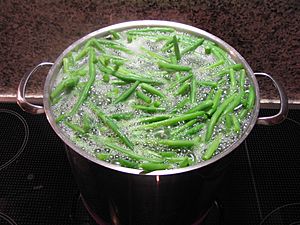 The first step in blanching green beans
The first step in blanching green beans - baghaar
- A cooking trick from Pakistani cuisine and Indian cuisine. You heat oil, add spices to fry them, and then pour this flavored oil into a dish to give it extra taste.
- bain-marie
- A gentle cooking method where a container of food is placed in or above boiling water. This heats the food slowly or keeps it warm.
- baking
- To cook food using dry heat, usually in an oven. Think of cakes, bread, or cookies!
- Barding
- Wrapping meat in fat, like bacon, before roasting. This keeps the meat moist and adds flavor.
- barbecuing
- Cooking meat or fish slowly over a barbecue grill using indirect heat and smoke. This gives food a smoky flavor.
- Basting
- Pouring liquid over food, like a roast chicken, while it cooks. This keeps it moist and flavorful.
- Blanching
- Dipping fresh food, like vegetables, into boiling water for a short time, then quickly putting it into ice water. This stops the cooking process and helps keep colors bright.
- Boiling
- Cooking food in water that is bubbling rapidly at a high temperature.
- braising
- A cooking method that uses both wet and dry heat. First, food is seared (quickly browned at high heat), then it's cooked slowly in a covered pot with some liquid.
- brine
- To soak food, often meat, in salty water. This adds flavor and helps keep it moist.
- Browning
- Partially cooking the surface of meat to remove extra fat and give it a brown color and flavor. This happens through chemical reactions when heat is applied.
C
- candy making
- Making candies by dissolving sugar in water or milk to form a syrup. This syrup is then boiled until it reaches a certain thickness or starts to caramelize.
- caramelization
- The process of browning sugar. This is used a lot in cooking to create a nutty flavor and a brown color.
- carryover cooking
- When food keeps cooking even after you take it off the heat. This happens because it holds onto heat.
- casserole
- A dish that is cooked and served in the same deep baking dish, often with many ingredients mixed together.
- charbroiler
- A cooking device with grates that are heated to cook food, often used for grilling meats like hamburgers.
- cheesemaking
- The process of making cheese from milk.
- chiffonade
- A knife cut where leaves, like herbs or lettuce, are cut into long, thin strips.
- Clay pot cooking
- Cooking food in a pot made from natural, unglazed clay. This method often keeps food moist and flavorful.
- coddling
- Heating food in water that is just below the boiling point. Coddled eggs are often made this way.
- concasse
- To roughly chop any ingredient, especially vegetables. For example, tomato concasse means a tomato that has been peeled, seeded, and chopped.
- confit
- A general term for foods cooked slowly in fat, oil, or sugar syrup. Duck confit is a famous example.
- consommé
- A type of clear soup made from a rich, flavorful broth that has been carefully clarified (made clear).
- cooking with alcohol
- Many dishes include alcoholic beverages in the food itself to add flavor.
- Creaming
- 1. Mixing ingredients, usually butter and sugar, until they are smooth and fluffy.
- 2. Cooking meat or vegetables in a thick sauce made with dairy.
- croquette
- A small, breaded, and fried roll made from finely chopped meat or vegetables.
- curdling
- When a liquid mixture, like milk or a sauce, separates into thicker parts and thinner liquid. This is good for making cheese but not always for sauces.
- Curing
- A way to preserve and flavor foods like meat, fish, or vegetables by adding salt, nitrates, or sugar. Many curing methods also involve smoking.
-
-
The production of Gruyère cheese at the cheesemaking factory of Gruyères, Switzerland
-
A coddled egg atop hash
-
D
-
A beef stew being cooked in a Dutch oven
- deep frying
- Cooking food by completely covering it in hot oil or fat. Think of french fries or fried chicken.
- Deglazing
- Adding liquid to a hot pan after cooking meat to loosen and dissolve the browned bits stuck to the bottom. These bits add a lot of flavor to sauces.
- Dredging
- Coating the outside of food with a dry material, like flour or breadcrumbs, before cooking.
- Drying
- Preserving food by removing its moisture. This can be done with a modern food dehydrator or by letting sunlight and air dry the food naturally.
- dum pukht
-
- A cooking method from India where meat and vegetables are cooked over a very low flame, usually in sealed containers. This keeps all the flavors inside.
- Dutch oven cooking
- Using a Dutch oven, a heavy pot, for long, slow cooking. It's great for roasts, stews, and casseroles, and often used for outdoor cooking like camping.
E
-
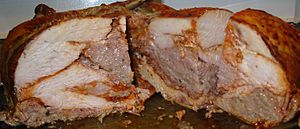 Engastration: the inside of a sausage-stuffed turducken
Engastration: the inside of a sausage-stuffed turducken - earth oven
- A shallow pit dug in the ground that is used to trap heat. It can bake, smoke, or steam food.
- egg wash
- A mix of beaten eggs, sometimes with water or milk, brushed onto pastries before baking. It gives them a shiny, golden crust.
- emulsify
- To combine two liquids that usually separate, like oil and vinegar, into one smooth mixture. Mayonnaise is an emulsion.
- en papillote
- A French cooking method where food is placed inside a folded pouch or parcel, usually made of parchment paper, and then baked. The food steams in its own juices.
- engastration
- A cooking method where one animal is stuffed inside another animal. A famous example is a turducken (a chicken stuffed into a duck, stuffed into a turkey).
- engine cooking
- Cooking food using the extra heat from an internal combustion engine, like a car or truck engine. This is usually done for fun or in emergencies.
F
-
 Bananas Foster being flambéed
Bananas Foster being flambéed - Fermentation
- A process where tiny living things (like yeast or bacteria) change food, often creating new flavors or helping to preserve it. Examples include making yogurt, cheese, or sourdough bread.
- Fillet
- To remove the bones from meat or fish, creating a boneless piece.
- flambé
- To pour alcohol over food and then light it on fire. This burns off the alcohol but leaves a subtle flavor and looks impressive!
- Foam
- A light, airy food substance created by trapping air in a gelling or stabilizing agent. Think of whipped cream or meringue.
- food preservation
- Methods used to keep food from spoiling, so it can be stored and eaten later. This includes canning, drying, and pickling.
- frying
- Cooking food in hot oil or fat.
- Chicken frying
- A method where a piece of beefsteak is coated in batter and then pan-fried, similar to how fried chicken is made.
G
-
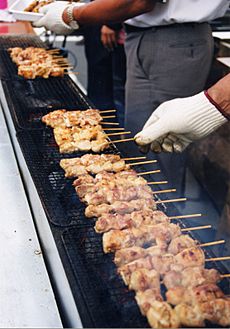 Yakitori being grilled
Yakitori being grilled - Garnish
- 1. (v.) To add a decorative, often edible, element to a plate of food before serving. It makes the dish look nicer.
- 2. (n.) The decorative element itself. Parsley is a common garnish.
- Glazing
- To coat food with a shiny, often sweet or savory, mixture. This adds flavor and a nice appearance.
- grilling
- Cooking food over direct heat, usually on a grill. This often creates grill marks and a smoky flavor.
H
- Hāngī
- A traditional New Zealand Māori cooking method using heated rocks buried in a pit oven. It's still used for special events.
- high-altitude cooking
- Cooking food or drinks at high elevations, where lower air pressure makes most foods cook slower. Special techniques might be needed.
I
- indirect grilling
- Cooking on a grill where the food is not directly over the heat source. This allows for slower, more even cooking.
- Infusion
- Soaking plant material, like herbs or tea leaves, in a liquid (water, oil, or alcohol) to extract its flavors or compounds. Tea is a common example.
J
- Jugging
- A method of stewing whole animals, especially game or fish, for a long time in a tightly covered container like a pot or jug.
- Julienne
- A knife cut where food, usually vegetables, is cut into long, thin strips, like matchsticks.
K
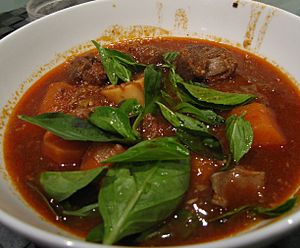
Bo Kho (beef stew)
- kalua
- A traditional Hawaiian cooking method that uses an imu, which is a type of underground oven. It's often used for large feasts.
- karaage
- A Japanese cooking technique where various foods, often chicken, are deep-fried in oil after being coated in starch. It's similar to tempura.
- Kho
- A cooking technique in Vietnamese cuisine where a protein, like fish or pork, is slowly cooked (braised) in a mix of fish sauce, sugar, and water or coconut juice. It's like a stew.
- kinpira
- A Japanese cooking style that combines sautéing (cooking quickly in a little fat) and simmering (cooking gently below boiling). It's often used for root vegetables.
L
- Larding
- Threading strips of chilled pork fat through a roast. This adds moisture and flavor to leaner meats.
- low-temperature cooking
- Cooking food at a lower temperature for a longer time. This can make meats very tender.
M
- marination
- Soaking food in a seasoned, often acidic, liquid called a marinade before cooking. This adds flavor and can make tough cuts of meat more tender.
- Microwave cooking
- Cooking food in a microwave oven using microwave radiation to heat the food quickly.
- mincing
- Chopping food into very tiny, fine pieces.
- Mongolian barbecue
- A style of cooking where raw ingredients are cooked quickly on a large, round, flat griddle.
N
- nixtamalization
- A process for preparing maize (corn) or other grains. The grain is soaked and cooked in an alkaline solution, usually limewater, and then hulled (outer layer removed). This makes the corn more nutritious.
O
- once-a-month cooking (OAMC)
- A method of preparing and cooking all the meals needed for an entire month in just one day. This helps save time later on.
- Outdoor cooking
- Cooking in outdoor places, like camping. This often needs special tools and ways of cooking food.
P
- pan frying
- Cooking food in a pan with only a small amount of oil or fat, just enough to coat the bottom of the pan.
- parboiling
- Partially boiling food, often as the first step in a longer cooking process. The food is cooked in boiling water until it just starts to soften, then finished with another method like braising.
- pasteurization
- A process of heating liquids, like milk, to a specific temperature for a set time to kill harmful bacteria without greatly changing the food's quality.
- pickling
- Preserving food by soaking it in an acidic liquid, usually vinegar or brine. This gives food a tangy flavor.
- Poaching
- Cooking food gently in a liquid that is just below the boiling point. This method is often used for delicate foods like eggs or fish.
- pressure cooking
- Cooking food in a sealed pot called a pressure cooker. The pot builds up steam pressure, which cooks food much faster than regular boiling.
- Proofing
- Allowing bread dough to rise in a warm place before baking. This makes the bread light and airy.
- purée
- To blend or mash food until it is a smooth, thick paste or liquid. Think of mashed potatoes or tomato purée.
R
- Reduction
- Cooking a liquid, like a sauce or stock, until some of the water evaporates. This makes the liquid thicker and more flavorful.
- roasting
- Cooking food, especially meat or vegetables, in an oven or over an open fire using dry heat. This often creates a browned, flavorful outside.
- rotisserie
-
- Cooking meat on a rotating spit over a heat source. This ensures even cooking and a crispy exterior.
- roux
- A thickening agent made by cooking equal parts of flour and fat (like butter) together. It's used to thicken sauces and soups.
S
-
- sautéing
- Cooking food quickly in a small amount of hot fat in a pan. This often means tossing or stirring the food frequently.
- Score
- To make shallow cuts, often in a diamond pattern, on the surface of meat. This helps it cook evenly and absorb flavors.
- searing
- Cooking the surface of food, usually meat, at a very high temperature until a browned crust forms. This locks in juices and adds flavor.
- seasoning
- Adding salt, pepper, herbs, or spices to food to enhance its flavor.
- simmering
- Cooking food gently in liquid just below the boiling point. The liquid will have small bubbles rising to the surface.
- Skimming
- Removing foam or fat from the surface of a liquid, like soup or stock, using a spoon or skimmer tool.
- slow cooker
- An electric cooking pot that cooks food at a low temperature for many hours. It's great for stews and roasts.
- Smoking
- Cooking or flavoring food by exposing it to smoke from burning wood. This adds a distinct smoky taste and can also preserve food.
- sous-vide
- A cooking method where food is sealed in a vacuum-sealed bag and cooked in a water bath at a very precise, controlled temperature. This ensures even cooking and tender results.
- Spatchcock
- Preparing poultry or game by removing its backbone and flattening it out before cooking. This helps it cook faster and more evenly.
- steaming
- Cooking food using the hot vapor (steam) from boiling water. This is a healthy way to cook as it keeps nutrients in the food.
- steeping
- Soaking food in a liquid to extract flavor or soften it, similar to making tea.
- stewing
- Cooking food slowly in a liquid, usually in a covered pot, for a long time. This makes tough cuts of meat tender and blends flavors well.
- stir frying
- Cooking food quickly in a hot wok or pan with a small amount of oil, while continuously stirring or tossing. It's common in Chinese cooking.
- stuffing
- An edible mixture, often made with bread or rice, used to fill a space inside another food item, like a turkey or bell pepper.
- Sweating
- Gently heating vegetables in a little oil or butter until they become tender and sometimes clear, but without browning them.
T
- tandoor
- A cylindrical clay or metal oven used in cooking and baking in parts of Asia. It cooks food at very high temperatures, often used for naan bread and tandoori chicken.
- Tempering
- 1. Tempering (chocolate): A method to make chocolate shiny and strong by carefully heating and cooling it.
- 2. Tempering (cooking): Bringing meat to room temperature before cooking, or slowly bringing food up to temperature, like in sous-vide.
- 3. Tempering (spices): A cooking technique from Indian and Pakistani cuisines where whole spices are briefly fried in oil or ghee to release their flavors. This flavored oil is then poured into a dish.
- Tenderizing
- A process to break down tough parts in meat, making it softer and easier to chew and enjoy.
- Thermal cooking
- Using the idea of a haybox, where a hot pot of food is placed inside an insulated box (like one filled with hay) to continue cooking slowly without needing more fuel.
- thickening
- Making a liquid, like a sauce or soup, thicker. This can be done with a roux, cornstarch, or by reducing the liquid.
- Truss
- To tie the legs and wings of poultry (like a chicken or turkey) with string. This helps the bird cook more evenly and keeps its shape.
- turkey fryer
- A large pot and burner system used to deep-fry a whole turkey, often outdoors.
V
- velveting
- A technique from Chinese cuisine where pieces of raw meat or poultry are coated in a mixture of cornstarch and liquid before cooking. This makes the meat very tender and smooth.
W
- Whip
- To beat food vigorously with a whisk or mixer to incorporate air and make it light and fluffy, like whipping cream or egg whites.
- Wok cooking
- Using a wok, a large, round-bottomed pan, for many different cooking methods, especially stir frying.
Z
- Zest
- The colorful outer layer of citrus fruits, like lemons or oranges. It's scraped off and used to add strong flavor to dishes.
|
See also
- Lists of food and beverage topics
- Culinary arts
- Food preparation
- Food science
- Food processing
- Meal preparation
- Outline of food preparation

All content from Kiddle encyclopedia articles (including the article images and facts) can be freely used under Attribution-ShareAlike license, unless stated otherwise. Cite this article:
List of cooking techniques Facts for Kids. Kiddle Encyclopedia.

